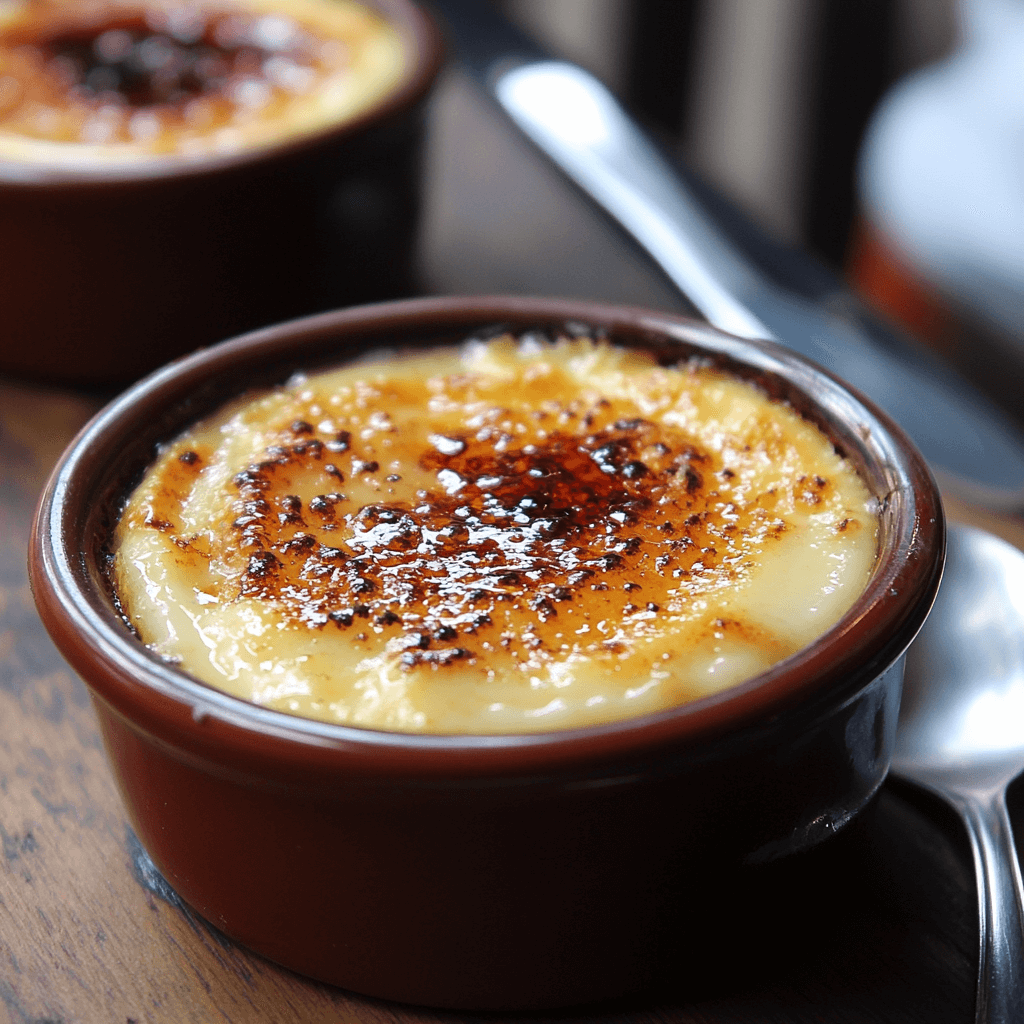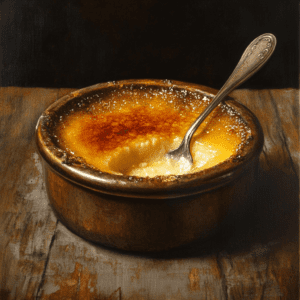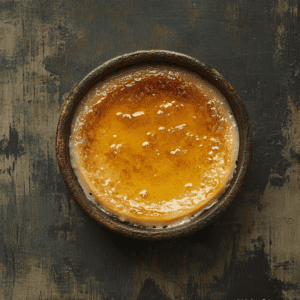Crème brûlée vs. custard—while these two desserts share a common base of eggs, cream, and sugar, they are fundamentally different in texture, preparation, and flavor. Crème brûlée is celebrated for its signature caramelized sugar crust, offering a delightful crunch, whereas custard’s smooth, creamy consistency makes it a versatile element in both sweet and savory dishes. This article dives into the fascinating contrasts between crème brûlée and custard to help you appreciate their unique characteristics.
In this comprehensive article, we’ll explore the nuances of crème brûlée and custard, comparing their origins, preparation methods, flavors, and more. Let’s dive into the world of these luxurious desserts.
Introduction to Crème Brûlée and Custard
Crème brûlée, known for its caramelized sugar topping, and custard, a versatile base for both sweet and savory dishes, share a common foundation of eggs, sugar, and dairy. However, their unique preparation methods and textures highlight the creativity behind each dessert. By understanding these differences, you’ll gain insight into when and how to best enjoy each one.
While crème brûlée is celebrated for its caramelized sugar topping, custard is renowned for its versatility in both sweet and savory dishes. By the end of this article, you’ll not only be able to tell them apart but also understand when and why each one should be the star of your next culinary creation.
Crème Brûlée vs Custard: What’s the Difference?
Origins of Crème Brûlée
Crème brûlée, meaning “burnt cream” in French, is a dessert with a rich history dating back to the 17th century. The first recorded recipe appeared in François Massialot’s cookbook, Le Cuisinier Royal et Bourgeois, published in 1691. Interestingly, similar desserts existed in Spain and England, such as crema catalana and Cambridge burnt cream, leading to debates about its true origins. Today, crème brûlée remains synonymous with French culinary elegance.
The History of Custard
Custard’s history is even older, with its origins traced back to ancient Rome. Early forms of custard were thickened with eggs and used as fillings for pies or tarts. Over time, it became a standalone dessert, popularized in European cuisines during the Middle Ages. From flans in Spain to egg tarts in Portugal, custard has taken on many forms, adapting to local tastes and traditions.
Ingredients in Custard vs Crème Brûlée
Crème Brûlée Ingredients
Crème brûlée typically consists of heavy cream, egg yolks, sugar, and vanilla. The simplicity of its ingredients belies the complexity of its preparation. The heavy cream gives it a rich, luxurious texture, while the caramelized sugar topping adds a crisp contrast to its creamy interior.
Custard Ingredients
Custard, on the other hand, is more flexible. It uses milk or cream, eggs, sugar, and optional flavorings like vanilla, nutmeg, or citrus zest. The choice of milk or cream impacts the final texture, making custard lighter or richer depending on the recipe.
Both desserts depend on the perfect balance of these ingredients, but the differences in their ratios and additional steps in preparation set them apart.
Texture and Flavor Comparison: Custard vs Crème Brûlée
Crème Brûlée vs Custard: How They’re Made
Crème brûlée is prepared by mixing egg yolks with sugar until pale and creamy. Warmed cream is slowly incorporated to avoid curdling. This mixture is poured into ramekins and baked in a water bath at a low temperature to ensure even cooking. Once set, it is chilled and topped with sugar, which is caramelized with a torch or under a broiler to create its signature hard crust.
Custard vs Crème Brûlée in Popular Variations
Custard preparation varies based on the type. For a baked custard, the mixture is poured into a dish and baked gently, similar to crème brûlée. For stirred custards, such as pastry cream, the mixture is cooked on the stovetop while constantly whisking to prevent curdling. This versatility makes custard a staple in countless dishes, from tarts to trifles.
Texture and Consistency
Crème brûlée is renowned for its silky texture beneath a crunchy sugar layer. The cream-heavy base ensures a rich and luxurious mouthfeel, while its baked preparation allows it to hold its shape.
Custard, however, offers a broader range of textures. A baked custard is smooth and firm, while a stirred custard can be velvety and pourable, depending on how it’s cooked. This adaptability makes custard a favorite ingredient for various desserts.
Flavors and Aromas
Crème brûlée’s defining flavor is its caramelized sugar topping, which adds a slightly bitter contrast to the sweet, creamy base. Vanilla is the most common flavor, though modern variations include chocolate, coffee, or even lavender.
Custard, being more neutral, serves as a canvas for endless flavor possibilities. From classic vanilla and cinnamon to tropical fruits and liqueurs, custard adapts to any flavor profile. Its aroma is equally inviting, with subtle notes of cooked milk and eggs blending harmoniously with added spices or extracts.
Presentation and Serving Styles
Crème brûlée is almost always served in individual ramekins, allowing diners to crack through the caramelized sugar with a spoon. The contrast between the crunchy topping and creamy base is a tactile delight that enhances its appeal.
Custard, in contrast, is incredibly versatile. It can be served on its own, layered in trifles, piped into pastries, or used as a base for tarts. Its ability to adapt to various presentations makes it a favorite among chefs and home cooks alike.
Nutritional Differences
Crème Brûlée Nutrition
Crème brûlée is undeniably indulgent, with high amounts of cream and sugar contributing to its rich taste and calorie content. A single serving can range from 200–300 calories, with significant fat content due to the cream.
Custard Nutrition
Custard can be lighter or richer depending on its preparation. Recipes using milk instead of cream are lower in calories and fat, making custard a more adaptable option for those watching their diet.
Popular Variations
Crème Brûlée Variations
Modern chefs have taken the classic crème brûlée to new heights by experimenting with innovative flavors and ingredients. Variations like matcha, coconut, and chai-spiced crème brûlée add unique twists to the traditional recipe, appealing to diverse palates. Some chefs also enhance the dessert’s complexity by incorporating fruits such as berries or passionfruit beneath the caramelized sugar topping, providing a burst of flavor and texture that complements the creamy custard. These creative adaptations showcase the versatility of crème brûlée while preserving its signature elegance.
Custard Variations
Custard offers an endless array of variations, making it one of the most versatile culinary creations. Beyond classic baked custards, there are stirred custards such as crème anglaise, which is often used as a dessert sauce, and chilled custards like flan, known for its smooth texture and caramel topping. Frozen custards, similar to ice cream, add yet another dimension by combining creamy richness with a refreshing chill. Each variation highlights custard’s adaptability, demonstrating how this simple yet elegant base can be transformed to suit a wide range of dishes and occasions.
Equipment Needed
For Crème Brûlée
Preparing crème brûlée involves using a few specialized tools to ensure its signature creamy texture and caramelized topping. Ramekins are essential for portioning the custard into individual servings. A water bath, or bain-marie, is used during baking to create gentle, even heat, which helps achieve the custard’s silky consistency. Finally, a kitchen torch is crucial for caramelizing the sugar on top, creating the iconic golden, crackly crust that defines this elegant dessert. Together, these tools are key to mastering crème brûlée’s texture and presentation.
For Custard
The preparation of custard varies depending on the type being made, but there are some essential tools and techniques common to most recipes. A whisk is crucial for blending the ingredients smoothly, while a saucepan is needed for heating the mixture. For baked custards, a baking dish is standard, often placed in a water bath to ensure even cooking. When making stirred custards, a thermometer can be invaluable for monitoring the temperature, as it helps prevent the eggs from overcooking and curdling, ensuring a perfectly creamy texture.
Common Challenges and Troubleshooting
Challenges with Crème Brûlée
- Cracking: This occurs when the custard is overcooked or cooled too quickly.
- Uneven Caramelization: Using a broiler instead of a torch can lead to uneven caramelization.
Challenges with Custard
- Curdling: This happens when the mixture overheats, causing the eggs to scramble.
- Watery Texture: Undercooking can prevent the custard from setting properly.
Tips for Success
- Use a water bath for even cooking.
- Monitor temperatures closely.
- Strain mixtures before baking or cooking to remove lumps.
Crème Brûlée vs. Custard in Culinary Use
Crème brûlée is primarily a standalone dessert, cherished for its elegance and simplicity. Custard, on the other hand, is a culinary chameleon. It can act as a filling, topping, or standalone dish, making it indispensable in both sweet and savory recipes.
Cost and Accessibility
Crème brûlée’s ingredients are straightforward but may require specialized tools like a torch, which adds to its cost. Custard is more budget-friendly and accessible, with ingredients and equipment already available in most kitchens.
Global Popularity and Cultural Significance
Crème brûlée has become synonymous with fine dining worldwide, a symbol of sophistication on dessert menus. Custard, however, has a more global reach, appearing in diverse forms like British custard pies, Portuguese egg tarts, and Asian custard buns.
FAQs About Crème Brûlée and Custard
Is crème brûlée a type of custard?
Yes, crème brûlée is a baked custard dessert characterized by its creamy, velvety base and topped with a caramelized sugar layer. The caramelized topping, achieved by using a kitchen torch or broiler, adds a delightful crunch and a slightly bitter sweetness that perfectly complements the rich custard beneath.
Can custard replace crème brûlée?
Not exactly. While custard can replicate the smooth, creamy texture of crème brûlée, it does not include the signature caramelized sugar topping that defines the classic dessert. This caramelized layer adds a distinct crunch and flavor contrast, making it an essential element of crème brûlée that custard alone cannot provide.
What tools are essential for crème brûlée?
A kitchen torch is an essential tool for creating the perfect caramelized topping on dishes like crème brûlée, as it allows for precise control over the heat, resulting in a beautifully even, golden crust. However, if a torch isn’t available, a broiler can be used as a convenient alternative. While it may require more careful attention to avoid burning, the broiler can still provide a satisfying caramelization when used properly. Be sure to keep a close eye on the process and rotate the dish as needed to ensure an even finish.
What are some savory custard options?
Quiches and savory flans are fantastic examples of savory custards, showcasing the versatility of this dish. These recipes combine the creamy texture of a custard with savory ingredients like cheese, vegetables, and meats, creating a rich and satisfying meal or appetizer. Whether served warm or at room temperature, quiches and flans are perfect for brunches, lunches, or elegant dinner spreads.
How do you avoid curdling in custards?
To achieve the best results, cook the mixture slowly over low heat, ensuring it doesn’t overheat or scorch. Stir constantly to maintain an even consistency and prevent the ingredients from sticking to the bottom of the pan. It’s important to monitor the temperature closely, as maintaining precise control will help achieve the desired texture and flavor without compromising the dish.
What’s the best occasion for serving these desserts?
Crème brûlée is perfect for formal dinners, offering a sophisticated touch with its rich custard base and caramelized sugar topping. On the other hand, custard is versatile and suits casual or festive occasions, providing a comforting and adaptable dessert option for a variety of settings.
Conclusion
Crème brûlée and custard are both culinary masterpieces, each with its unique charm. While crème brûlée dazzles with its caramelized sugar crust and luxurious texture, custard stands out for its versatility and adaptability. Understanding their differences allows you to appreciate their artistry and choose the perfect dessert for any occasion.
Whether you’re crafting a decadent crème brûlée or a comforting bowl of custard, both desserts offer a delightful way to indulge your sweet tooth.
Related article:



